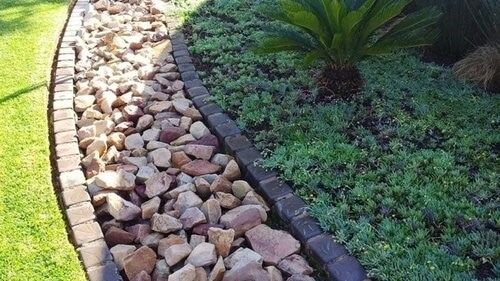All the Essentials About the Portland French Drain Process
All the Essentials About the Portland French Drain Process
Blog Article
The Necessary Guide to Maintaining Your French Drain for Long-Lasting Performance
Maintaining your French drain is vital to its efficiency and your property's protection. Normal checks can save you from costly repair services and water damage. You'll would like to know what signs to try to find and how usually to evaluate your system. Plus, recognizing the cleaning procedure can make a considerable distinction. Allow's check out the important actions for guaranteeing your drainpipe operates well for years ahead.
Understanding the Feature of a French Drainpipe
A French drain is a vital element in managing water around your home. It routes excess water far from your foundation, avoiding flooding and damages. When heavy rainfall falls, the drain accumulates water via a perforated pipeline hidden in crushed rock. This system allows water to move openly, minimizing pressure on your cellar walls and decreasing the risk of leaks.You might question how it works in practice. As water saturates the dirt, gravity pulls it toward the drainpipe. The perforated pipe catches this water, carrying it to an assigned drain area or tornado drain. This procedure keeps your backyard dry and shields your home's architectural integrity.Understanding just how a French drainpipe features is key to valuing its significance. By effectively directing water away, it assists preserve a risk-free and completely dry living atmosphere. So, keeping your French drain in top problem guarantees you prevent costly repairs down the line.
Routine Inspections: What to Seek
Start by inspecting for any kind of blockages that could be blocking water circulation when you're inspecting your French drain. Take notice of signs of surface area disintegration around the drain, as this can suggest possible problems. Normal evaluations will help keep your water drainage system functioning effectively.
Obstructed Drain Assessment
How can you tell if your French drain is blocked? Watch for water pooling in your backyard, specifically after heavy rainfall. If you observe locations where water gathers instead of draining, that's a warning. You should likewise check the drainpipe electrical outlet; if water isn't draining as it should, there's likely an obstruction. Listen for unusual gurgling sounds, which can show trapped air. Additionally, evaluate the drainpipe's surface for any kind of plant life growth, as roots can block the system and penetrate. If you scent mildewy smells, it can direct to stagnant water caused by an obstruction. Routinely assessing these indications can assist you preserve your French drainpipe successfully and prevent pricey repair work.
Surface Area Disintegration Check

Cleaning Your French Drainpipe: Step-by-Step Overview
Cleansing your French drainpipe is important for keeping it working correctly. You'll need some specific tools and a clear process to ensure everything runs efficiently. Let's go through the actions and tips for keeping your drain effectively.
Devices You'll Need
To tackle the task of cleansing your French drain properly, you'll want to gather a couple of vital tools. First, grab a sturdy set of handwear covers to protect your hands from particles and sharp objects. A tiny shovel or trowel will assist you get rid of dust or blockages around the drain. For removing out the interior, a plumbing professional's snake or a high-pressure water nozzle can be unbelievably useful. You'll likewise need a pail for gathering any debris you take out. Finally, having a yard tube handy will make it less complicated to rinse out the drain and guarantee it's flowing efficiently. With these tools all set, you'll be established for a detailed cleansing session!
Cleaning Refine Steps
Beginning by evaluating the area around your French drainpipe for any visible debris or obstructions. Remove leaves, branches, or dust that might block water flow. Next, inspect the inlet and outlet areas; clear any type of obstructions to guarantee proper drainage. Make use of a garden tube to purge the drain, guiding water right into the inlet. This aids displace any type of built up sludge or sediment. Consider making use of a plumbing technician's serpent to damage them up if you discover relentless blockages. After cleaning, examine the crushed rock around the drainpipe; restore it if it's cleaned away. Verify the drain covers are undamaged and firmly in location to stop particles from entering. Regular cleaning keeps your French drain functioning successfully.
Maintenance Frequency Tips
While routine maintenance is important for your French drainpipe's longevity, understanding how usually to preserve it can make all the distinction. Ideally, you need to check your French drain at the very least two times a year, ideally in springtime and fall. After hefty rains or snowmelt, check for blockages or debris. If you discover any type of standing water, it's time to clean your drain.In areas with hefty vegetation, more frequent upkeep-- about every 3 months-- might be required. Additionally, take into consideration cleansing your French drain after significant storms or if you observe water pooling in your yard. By remaining positive, you'll ensure your French drainpipe functions efficiently and secures your residential property from water damage. Routine checks will certainly save you money and time over time.
Determining Typical Issues and Their Solutions
It's essential to identify typical concerns with your French drain and apply effective solutions when you see water pooling in your backyard or damp spots in your basement. One regular trouble is clogging, commonly caused by particles like fallen leaves or debris. To fix this, you can make use of a plumbing snake or pop over to this web-site a high-pressure water jet to clear blockages.Another problem may be inappropriate slope. If your drain isn't sloped appropriately, water will not flow far from your home. You can adjust the slope by excavating and rearranging the drainpipe pipe.Lastly, check for damage or fractures in the drainpipe itself. Changing the damaged areas is crucial for peak performance if you find any. By attending to these issues promptly, you'll assist guarantee that your French drain remains to work properly, safeguarding your property from water damages and maintaining a completely dry, risk-free atmosphere.
Seasonal Upkeep Tips for Your French Drain
Dealing with typical concerns with your French drainpipe is just the very first step in assuring its lasting efficiency. Seasonal maintenance is essential for peak performance. In the springtime, remove leaves and particles that might have built up throughout winter months. Check for any clogs in the outlet or capture basin, as water requires a clear path to move freely.During summer season, examine your drain for any indications of moving or resolving dirt. Make sure it's still degree and functioning properly. As autumn techniques, clean out any kind of fallen delegates protect against obstructions before winter season arrives.In winter, watch for freezing temperature levels. If you live in a chilly climate, make sure your drainpipe isn't in jeopardy of freezing. Insulating subjected pipelines can aid. Routine checks and timely upkeep can avoid expensive fixings and keep your French drain working efficiently year-round. Keep positive and appreciate comfort understanding your drain system remains in good condition!
When to Call an Expert
Knowing when to hire a professional can conserve you time and stop additional damage to your French drain. It's a clear sign that your drainpipe might be clogged or harmed if you notice persistent standing water in your backyard. Don't ignore odd smells, as they can suggest sewage back-up or degeneration, which requires prompt attention.If you discover that your drain isn't operating correctly after efforts to clean or preserve it, it's time to connect for professional assistance. In addition, if you're not sure regarding the underlying concerns or lack the needed tools, hiring a professional can give peace of mind.Finally, if your French drain is old or has actually experienced considerable damage, specialist assessment can figure out whether repair services or full substitute is required. Trust fund the specialists to guarantee your drain system works efficiently for years to find.
Tips for Protecting Against Future Drain Issues
To maintain your French drain working successfully, on a regular basis inspecting and keeping it can make all the distinction. Start by getting rid of particles, leaves, and dirt from the surface area and drain openings. This protects against clogs that can lead to water backup. Examine the gravel around the drainpipe; if it's compressed or worn down, take into consideration including fresh check this site out crushed rock to preserve optimal flow.Next, draw away water away from your drainpipe by making certain downspouts and rain gutters are clear and directing water at the very least three feet away from your structure. On a regular basis evaluate for any indications of damages or drooping. If you discover issues, resolve them immediately.Finally, think about mounting a catch or a filter basin to trap bigger particles prior to it gets in the drainpipe. By remaining proactive with these ideas, you'll decrease the risk of future drainage issues and keep your French drain in leading form.
Regularly Asked Inquiries
The length of time Does a French Drain Typically Last?
A French drain usually lasts around 30 to 40 years, relying on the materials used and upkeep (Portland French Drain). If you keep up with routine checks, you can prolong its life expectancy also further
Can I Install a French Drain Myself?
Yes, you can install a French drain yourself if you've got the right tools and knowledge. Simply make sure to plan very carefully, comply with local policies, and warranty proper drainage to prevent future problems.
What Products Are Made Use Of in a French Drain?
You'll require perforated pipe, crushed rock, landscape fabric, and a solid water drainage pipeline for your French drain. These materials assist reroute water efficiently, avoiding flooding and maintaining your home dry and safe from water damages.

Is an Authorization Required to Install a French Drainpipe?
You'll likely need a license to set up a French drain, relying on local policies. Get in touch with your town to ensure you follow any type of essential guidelines and prevent Website prospective concerns throughout installment.
What Are the Expenses Connected With French Drain Upkeep?
Preserving a French drainpipe generally sets you back in between $100 and $500 annually. You'll require to consider expenses for cleansing, repair work, and evaluations. Normal maintenance aids protect against bigger warranties and expenses your system functions correctly for years - Portland French Drain. When you're inspecting your French drainpipe, beginning by examining for any clogs that might be obstructing water circulation. By staying aggressive, you'll assure your French drain features successfully and secures your property from water damages. When you discover water merging in your backyard or damp areas in your cellar, it's crucial to recognize common problems with your French drain and carry out reliable solutions. You can readjust the incline by digging and repositioning the drain pipe.Lastly, check for damages or splits in the drainpipe itself. Inspect the crushed rock around the drain; if it's compacted or worn down, think about adding fresh crushed rock to keep optimal flow.Next, divert water away from your drainpipe by guaranteeing downspouts and seamless gutters are clear and guiding water at least 3 feet away from your foundation
Report this page